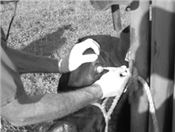Pinkeye Problems Showing Up In Area Beef Cattle 
A cow being treated for pinkeye
MT. VERNON, MO.
Pinkeye has been showing up in numerous beef cattle operations in southwest Missouri during the last four to six weeks according to Eldon Cole, livestock specialist with University of Missouri Extension.
The most susceptible animals are nursing calves and fall born 2016 weaned calves.
“It seems most adult animals escape the eye infection probably because they've been exposed to it in previous years which gives them a little immunity,” said Cole.
When cattle producers go to the pasture and find weepy-eyed animals or the animal is blind, they almost immediately say they have a pinkeye problem. Cole says there are several diseases and other factors that may be contributing factors.
SEVERAL FACTORS
Traditionally, pinkeye was blamed on the bacterial infection, Moraxella bovis. Research shows several bacterial, viral and mycoplasma infections may contribute to eye infections commonly called “pinkeye.”
Other factors involve eye irritants such as bright sunlight, dust, plant pollen, flies and poor nutrition which may weaken the animals immune system.
“It’s difficult to pinpoint an exact cause, but we know several factors may be involved,” said Cole.
Vaccinations with pinkeye vaccines have been around for years with limited success. More recently autogenous bacterins have been made using cultures from the infected herd.
“This approach improves the prevention and speeds up recovery time if the animals in that herd gets an eye infection,” said Cole.
Another Moraxella “family” bovoculi, is considered a possible cause of pinkeye infections.
“If you herd has a nagging eye problem, year-after-year, check with your veterinarian about a possible vaccination program. It may be a late this year for best control but check it out,” said Cole.
ECONOMIC IMPACT
Pinkeye, regardless of the cause, is a tremendous cause of lost income from local beef operations all the way through to the packer.
The program used by MU Extension in Iowa, Tri-County Steer Carcass Futurity, in conjunction with Iowa State University, tracks eye-infected cattle through to the carcass steers with eye scars gain 34 lbs. less while on the cow.
They continue to lag behind their non-pinkeye herd mates in the feedlot by 0.2 lb. per day.
“If you own cattle, you have likely had experience with eye infections, and affected calves will be spotted the instant they enter the sale ring. Usually, they will be sorted off and sold at a big discount,” said Cole.
To avoid eye problems, Cole recommends watching cattle closely and treat promptly.
“Treat it the day you find it,” said Cole. “If possible isolate affected animals to reduce the chance of more cattle in the herd coming down with bad eyes. Flies, especially face flies, are spreaders of eye problems so maintain fly control practices until frost.” ∆
|
|